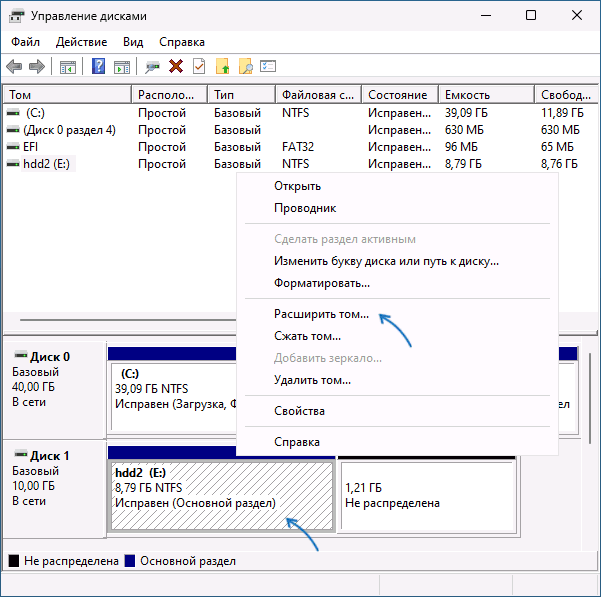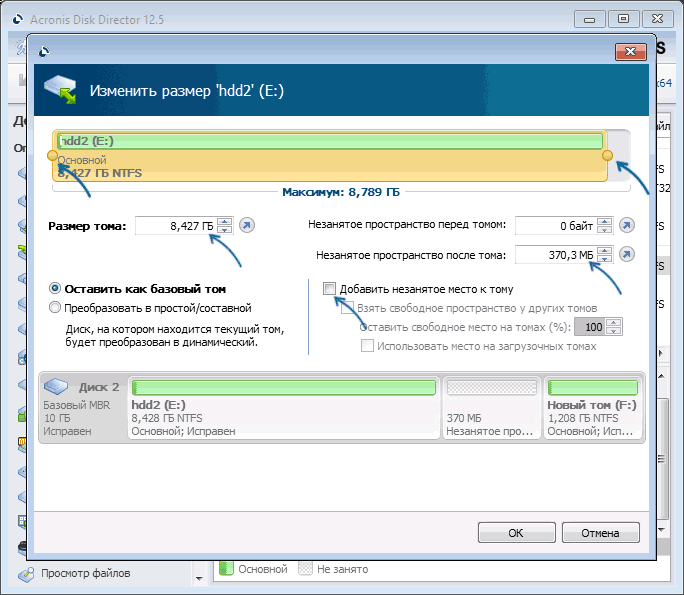Если вам требуется поменять размеры разделов диска HDD или SSD в Windows 11, Windows 10 и предыдущих версиях ОС — увеличить размер раздела, уменьшить его, либо выделить место под дополнительные разделы, сделать это сравнительно легко: в некоторых случаях достаточно прибегнуть к встроенным средствам системы, в других могут потребоваться сторонние программы.
В этой инструкции подробно о способах изменения размеров разделов диска в Windows актуальных версий в управлении дисками, командной строке или с помощью сторонних инструментов. На близкую тему: Как увеличить диск C.
Возможности изменения размеров разделов средствами Windows
В Windows присутствует два инструмента для работы с разделами: «Управление дисками» с графическим интерфейсом и DISKPART — инструмент командной строки. Возможности использования в части изменения разделов ограничены.
Сначала рассмотрим задачи, которые можно выполнить с помощью «Управления дисками». Для запуска утилиты вы можете нажать клавиши Win+R на клавиатуре и ввести diskmgmt.msc, либо нажать правой кнопкой мыши по кнопке «Пуск» и выбрать пункт «Управление дисками».
- Для большинства разделов с данными вы можете «Сжать том» — то есть уменьшить размер раздела. Нажмите правой кнопкой мыши по разделу, выберите «Сжать том» и укажите, на сколько его требуется сжать (не более, чем есть свободного места на выбранном разделе, в некоторых случаях — меньше). При этом область, которая высвободилась, будет помечена как «Не распределена» и будет расположена справа от раздела (высвободить её слева средствами системы не получится). Её можно будет использовать для создания нового раздела (с присоединением к другим разделам встроенными средствами системы не все просто).
- Если справа от раздела с данными есть область, которая «Не распределена» (или вы готовы удалить том, находящийся справа, чтобы создать такую область), вы можете расширить том на всю эту область («вправо»), либо на её часть, то есть увеличить размер раздела. Запустить расширение тома так же можно через контекстное меню по правому клику.
- Если область, которая «Не распределена» находится слева от раздела, который нужно увеличить, в некоторых случаях (если это не системный раздел) вы так же можете расширить том. Однако при этом диск будет преобразован в «Динамический», о чём вы увидите соответствующее уведомление. Это не всегда удобно, а потому я бы рекомендовал для таких целей использовать сторонние программы изменения размеров разделов.
Те же действия можно выполнить в командной строке:
- Запустите командную строку от имени администратора, например, используя поиск в панели задач.
- По порядку введите команды, нажимая Enter после каждой
diskpart list volume
- Обратите внимание на номер тома (раздела), над которым нужно произвести действия (далее — N) и введите команду
select volume N
- Если вам нужно сжать том, используйте команду (размер указываем в мегабайтах)
shrink desired=РАЗМЕР minimum=РАЗМЕР
- Если требуется расширить том, используйте команду
extend size=РАЗМЕР
Все условия о наличии незанятого пространства остаются теми же, что и в «Управлении дисками».
Как можно заметить, встроенные средства системы не позволяют гибко и удобно менять размеры разделов, особенно в случае наличия промежуточных разделов или если требуется выполнить какие-то операции без потери данных на уже имеющихся дисках и без преобразования в динамический диск. Во всех сложных случаях лучше будет воспользоваться сторонними программами.
Увеличение и уменьшение размеров разделов в сторонних программах
Существует множество условно-бесплатных программ, позволяющих гибко менять размеры разделов на дисках в удобном интерфейсе. Среди них:
- Aomei Partition Assistant Standard — есть русский язык интерфейса, функциональна, большинство функций по работе с размерами разделов доступны бесплатно.
- MiniTool Partition Wizard Free — все то же самое, что и для предыдущего варианта, но без русского языка интерфейса.
- DiskGenius — условно бесплатная программа, недавно появился русский язык интерфейса, почти все функции доступны и без приобретения.
- Acronis Disk Director — функциональная и русскоязычная программа, не бесплатная.
Это не полный список и, если вы не знаете, что выбрать, рекомендую использовать эти программы с загрузочной флешки WinPE Sergei Strelec (подробнее можно прочитать здесь), где вы найдете сразу все указанные, а также некоторые дополнительные средства для работы с разделами дисков, в том числе с изменением их размеров в разделе программ «Жесткий диск».

Сам процесс изменения размеров разделов почти одинаков во всех этих программах: обычно достаточно выбрать нужный раздел, а затем — нужное действие в списке инструментов, либо в контекстном меню. Несколько примеров:
- Aomei Partition Assistant — нажмите правой кнопкой мыши по разделу, выберите опцию «Перемещение и изменение размеров разделов», в следующем окне задайте размеры разделов, если нужно забрать часть свободного места от другого раздела, отметьте пункт «Назначьте свободное пространство из раздела в раздел». После настройки размеров, не забудьте нажать «Применить» в главном окне программы.
- Вторая возможность в Aomei Partition Assistant — использование функции «Распределить свободное пространство» для присоединения части свободного пространства с одного раздела к другому.
- DiskGenius — здесь то же самое: достаточно выбрать диск и раздел на нем, нажать правой кнопкой мыши и выбрать пункт «Resize Partiton» (изменить размер раздела), после чего уменьшить раздел (мышью или введя нужные числа), создав свободное пространство в начале или конце раздела, или увеличить его за счет находящегося рядом свободного пространства. Подтвердите изменение размера нажатием кнопки «Start». Если нужно увеличить размер, но свободного пространства нет, первым действием уменьшите соседний раздел, создав свободное пространство с той стороны, которая примыкает к разделу, который нужно расширить, а затем расширьте раздел, который требовалось увеличить.
- Acronis Disk Director — достаточно выбрать раздел, затем нажать по нему правой кнопкой мыши и выбрать пункт «Изменить размер тома». После этого вы сможете вручную настроить размер нового тома, введя нужные размеры (за счет свободного от разделов пространства) или с помощью мыши и регулировки в графическом представлении. Если свободного пространства нет, можно поставить отметку «Добавить незанятое место к тому», чтобы использовать свободное место от других разделов.
Как можно заметить, логика действий почти во всех программах примерно одинакова: с уменьшением размера раздела нет никаких проблем, и оно выполняется в пару кликов, а для увеличения раздела в некоторых программах может потребоваться предварительно уменьшить соседний раздел, чтобы рядом с расширяемым появилось незанятое пространство.
Надеюсь, инструкция была полезной. Если остаются вопросы, опишите задачу в комментариях, я постараюсь помочь.
Applies ToWindows 11 Windows 10
Управление дисками в Windows помогает выполнять дополнительные задачи с хранилищем, такие как инициализация нового диска, расширение и сжатие томов.
Чтобы открыть оснастку «Управление дисками», щелкните правой кнопкой мыши (или нажмите и удерживайте) кнопку Пуск и выберите Управление дисками.
-
Откройте управление дисками.
-
Выберите и удерживайте (или щелкните правой кнопкой мыши) диск, который нужно инициализировать, а затем выберите Инициализировать диск. Если диск указан как автономный, сначала выберите и удерживайте (или щелкните правой кнопкой мыши) диск, а затем выберите В сети.
Некоторые USB-диски не могут быть инициализированы. Эти диски только форматируются, а затем назначаются буквы диска.
-
В диалоговом окне Инициализация диска убедитесь, что выбран правильный диск, а затем нажмите кнопку ОК, чтобы принять стиль секции по умолчанию или изменить его при необходимости.
-
Используйте GPT , если у вас есть современная система с встроенным ПО UEFI и требуется поддержка больших дисков и более четырех секций.
-
Используйте MBR , если вы работаете с более старым оборудованием или операционными системами, которые не поддерживают UEFI.
Затем состояние диска кратко меняется на Инициализация, а затем на состояние «В сети«. Если инициализация по какой-либо причине завершается сбоем, см. статью Устранение неполадок с управлением дисками.
Чтобы создать раздел или том (эти два термина часто используют как взаимозаменяемые) на жестком диске, вам необходимо войти в систему с правами администратора. Кроме того, на жестком диске должно быть либо нераспределенное дисковое пространство, либо свободное место в дополнительном разделе.
Если нераспределенного дискового пространства нет, вы можете создать его, сжав или удалив один из существующих разделов либо использовав программу стороннего производителя для работы с разделами жесткого диска.
-
Откройте управление дисками.
-
Щелкните правой кнопкой мыши нераспределенную область на жестком диске, а затем выберите Создать простой том.
-
В мастере создания простого тома нажмите кнопку Далее.
-
Введите размер тома, который вы хотите создать, в мегабайтах (МБ) или подтвердите максимальный размер, заданный по умолчанию, а затем нажмите кнопку Далее.
-
Подтвердите букву диска, предложенную по умолчанию, или выберите другую букву диска для идентификации раздела, а затем нажмите кнопку Далее.
-
В диалоговом окне Форматирование раздела выполните одно из указанных ниже действий.
-
-
Если вы хотите отложить форматирование тома, выберите Не форматировать данный том, а затем нажмите кнопку Далее.
-
Чтобы отформатировать том, используя параметры, заданные по умолчанию, нажмите кнопку Далее.
-
-
Проверьте все выбранные вами параметры и нажмите кнопку Готово.
Примечание: При создании разделов на базовом диске первые три раздела будут отформатированы как основные разделы. Начиная с четвертого, каждый раздел будет настроен в качестве логического диска в дополнительном разделе.
Предупреждение: При форматировании тома все имеющиеся на нем данные будут уничтожены. Перед началом работы сделайте резервную копию всех нужных данных.
-
Откройте управление дисками.
-
Щелкните правой кнопкой мыши том, который вы хотите отформатировать, а затем выберите пункт Форматировать.
-
Чтобы отформатировать том, используя параметры, заданные по умолчанию, в диалоговом окне Форматирование нажмите кнопку ОК, а затем еще раз нажмите кнопку ОК.
Примечания:
-
Вам не удастся отформатировать диск или раздел, которые на момент попытки форматирования используются другими программами, а также раздел, содержащий Windows.
-
Параметр Выполнить быстрое форматирование создаст таблицу файлов, но не будет полностью перезаписывать или стереть том. Быстрое форматирование выполняется намного быстрее, чем обычное форматирование, при котором полностью стираются имеющиеся в томе данные.
Нужна дополнительная помощь?
Нужны дополнительные параметры?
Изучите преимущества подписки, просмотрите учебные курсы, узнайте, как защитить свое устройство и т. д.
Position: How Tos — Partition Management — How To Resize Partition in Windows 11/10/8/7 Without Data Loss? — 3 Ways
Table of Contents
About resizing partition in Windows 11/10/8/7/XP
Resizing a partition is the process of changing partition’s size via extending or shrinking it. You can either increase a partition’s size or shrink it based on your needs. Besides, you can also split a partition into two partitions or add free disk space to any existing partition.
A partition, also called drive or volume, is a part of continuous logical space on hard disk. A hard drive can be divided into multiple partitions which can be used to store a variety of files such as operating system and personal data. If your hard drive has very large capacity, and you can create more than one partitions on it, so that you can separate Windows, installed application and individual data by storing files on different partitions.
However, when you partition a hard disk, there might be chances that you are not satisfied with the partition size or number the first time you try. For example, one partition might be too small to hold all your data. If your system partition (Windows drive) is running out of free space, computer may slow down or even cause other issues.
How do I resize a partition in Windows 10 for free? Fortunately, resizing partition in Windows 10, Windows 8, Windows 7, Windows Vista and Windows XP becomes a lot easier than previous versions of Windows systems. We can use system built-in tool to resize volume as well as free partition manage to change partition size without data loss. In this article, we’ll show you different methods to resize partition in Windows.
There are a number of reasons that users want to change partition size, and here we list the most common ones:
- To make best use of disk space: Due to the daily increasing of data amount, some partition may be full of data, while some partition still has large free space. You can move free disk space between to take full advantage of space.
- Low disk space issue appears: You receive error message from Windows, which says «You are running out of disk space on Windows (C:). To free space on this drive by deleting old or unnecessary files, click here…» «You are running out of disk space on Recovery (D:). Click here to see if you can free space on this drive.» Deleting files is not recommended on system partition, for you may delete vital system files and cause system crash. In such situation, you can extend partition to fix the issue.
- There is only one big partition on hard disk. When you buy a new PC, the hard drive is divided into one big partition. You can shrink this volume and create a new partition on unallocated space.
- You want to dual-booting compute. You may want to install another operating system such as Ubuntu on same hard drive, but the partition does not have enough room. Thus you need to extend partition for the installation of new operating system.
Method #1: Resize partition using Disk Management
Disk Management is a Windows built-in utility, first introduced in Windows XP for the purpose of replacing fdisk command. It allows users to view and manage disk volumes on computer. Users can view disk layout, file system, status, capacity, type, etc. Besides, it allows users to create, delete, format extend or shrink partition with easy steps. Now we’ll show you how to resize partition in Windows Disk Management.
Step 1. Open Disk Management: Go to desktop and right-click on This PC («Computer» in Windows 7) icon and click Manage option from context menu. Click Disk Management under Storage from the Computer Management window.
Step 2. Choose the partition you want to resize, right-click on it and select «Shrink Volume» option. If you want to increase the partition size, then choose «Extend Partition«.
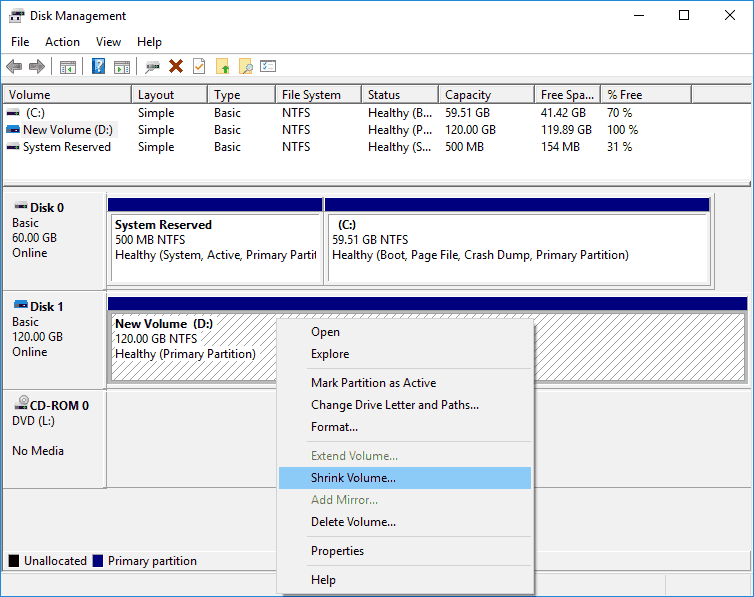
Step 3. Input the space you want to change and click «Shrink button«. When you enter the amount of space to shrink, please note the unit is MB, for example, if you want to shrink 10GB from this volume, you should input 10240.
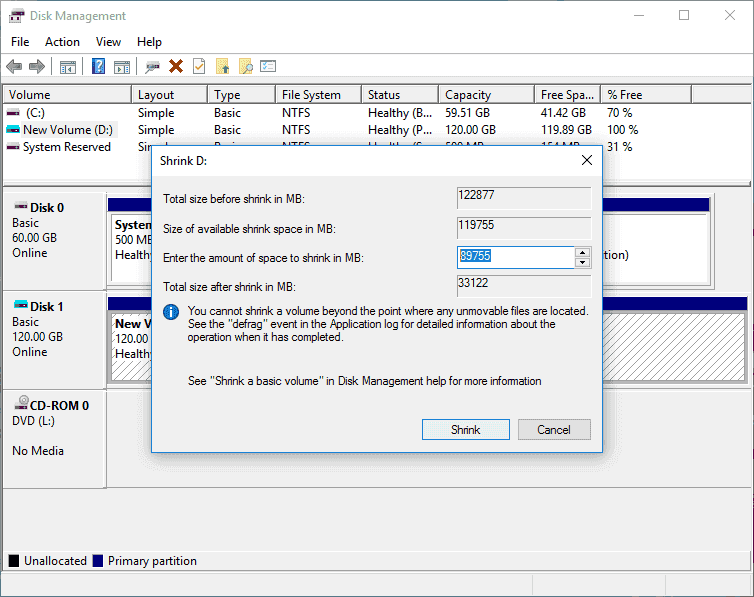
Method #2: Resize partition with free partition manager
This solution gives three examples to show how to extend and shrink partition as well as add free space to an existing partition without losing data. In this section, we use a free partition manager program to complete these tasks.
Free Download free partition manager to resize partition in Windows
DiskGenius Free is high-end Windows partition manager software, and it is compatible with all versions of Windows systems including PC and server OS. It allows users to create, format, delete and convert partition; it is also able to move, resize, extend, shrink and split partition without damaging a single bit of data.
- It is supportive over different file systems, including NTFS, exFAT, FAT32, FAT12, FAT16, Ext2, Ext3 and Ext4. Thus you can resize partitions formatted into these filesystems.
- Support resizing partition on both MBR and GPT disks.
- Add unallocated space to any existing partition without data loss.
- Create WinPE bootable disk so that you can manage disk and partition when system fails to boot.
- Recover deleted or lost files & partitions from hard drive, USB disk and virtual disk.
Example #1: Extend partition without data loss
This guide below will extend a partition by moving free space from one partition to another without damaging existing data, and steps below also apply to extend C drive.
Step 1. Download and install DiskGenius Free Edition on your computer. Run the software and you can see its interface showing all partitions and disks on your computer with detailed parameters.
Step 2. Find and right-click on the partition you want to increase size and select «Extend Partition» from the displayed menu.
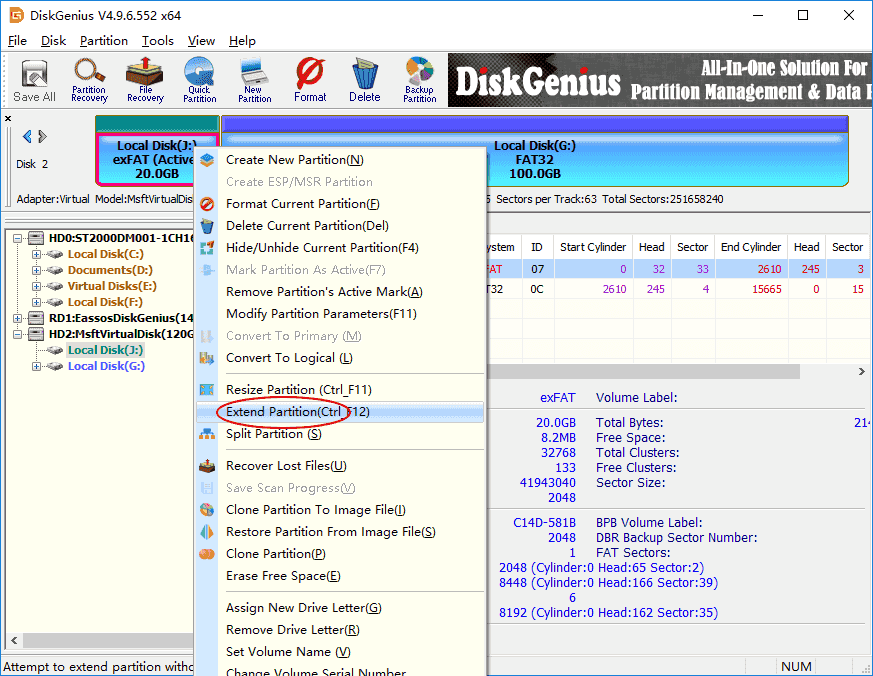
Step 3. Select the partition which contains enough free space and click «OK«, so that you can move free disk space from this volume.
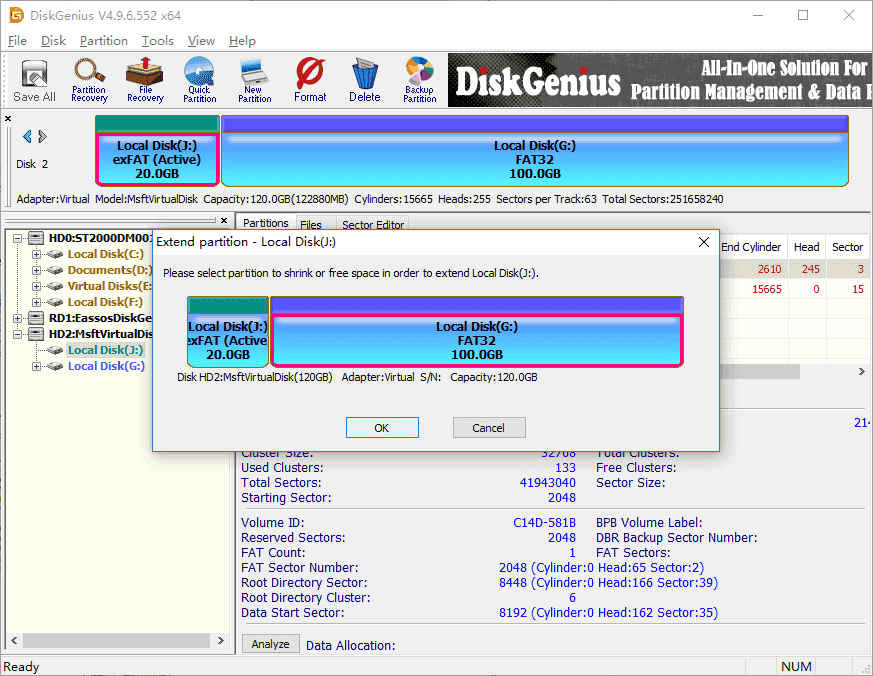
Step 4. Set disk space you want to move between partitions. You can either drag the partition or enter exact number to decide how much free space you want to transfer. Then click «Start» button.
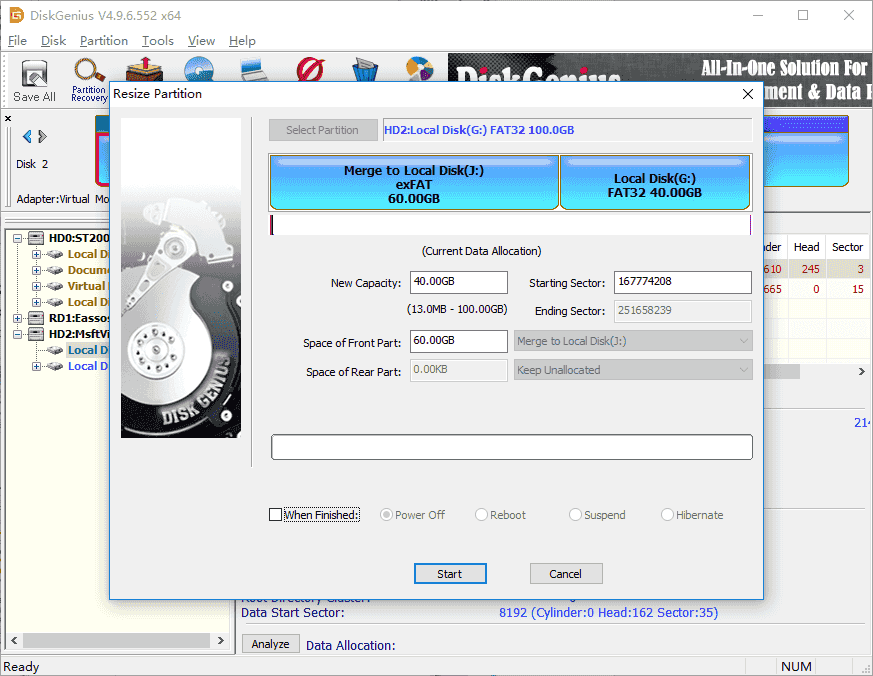
Step 5. The program starts to resize partition based on your settings. Wait for the process to complete.
Example #2: Shrink partition without losing data
This tutorial shows you how to shrink a partition without data loss. The disk space shrunk from the disk can be added to other partitions, kept unallocated or created new partition.
Step 1. Right-click on the partition you want to shrink and select «Resize Partition» from context menu.
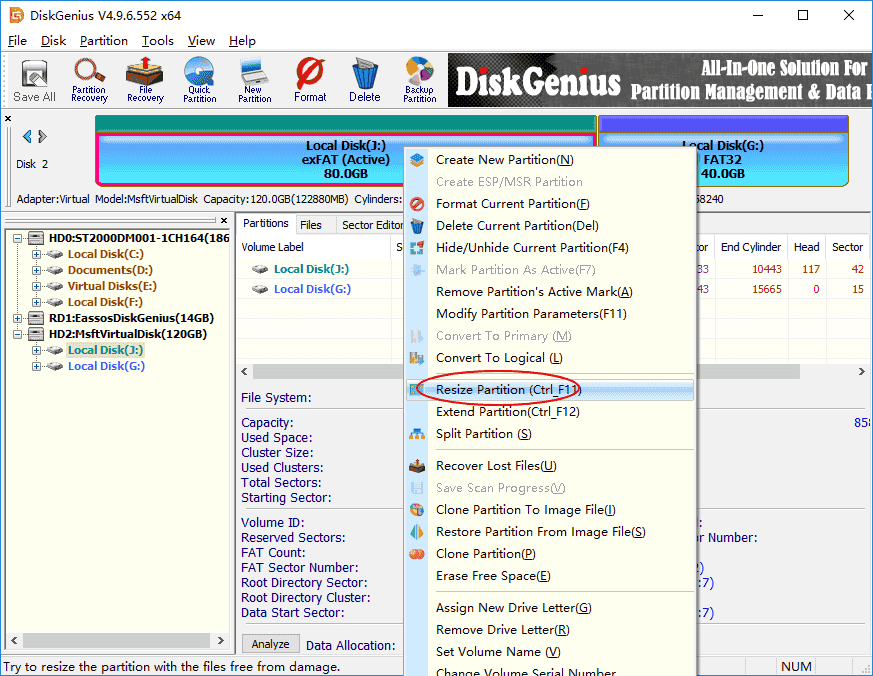
Step 2. On the Resize Partition window you can set disk space you want to decrease.
You have three options on the disk space cut from the big partition: «Create New Partition», «Keep Unallocated» and «Merge to Local Disk». You can make the decision in line with your own requirement.
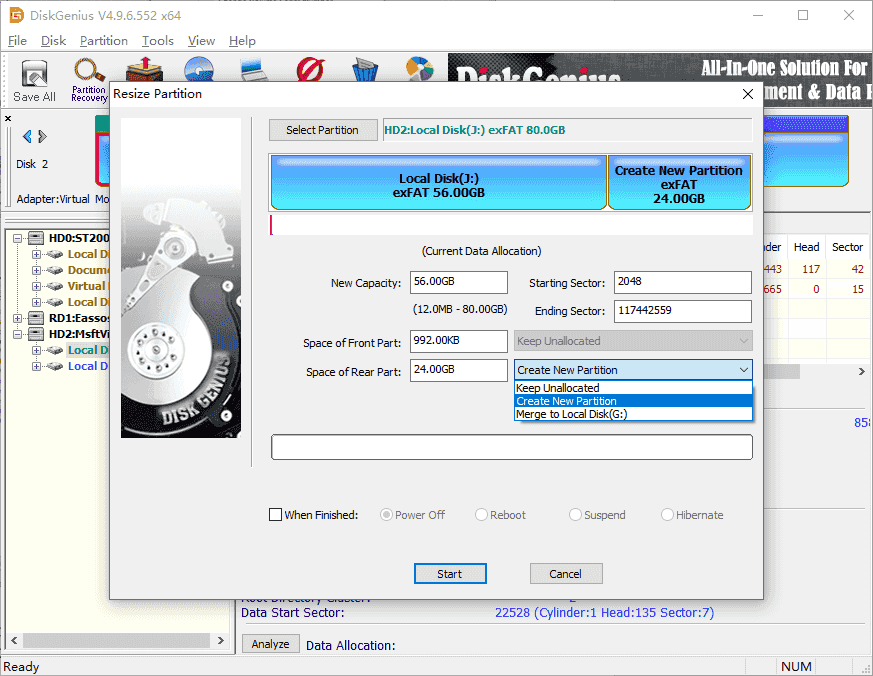
Step 3. Click «Start» button and the program starts to resize the partition based on your settings. Click «Complete» button when the process finishes.
Example #3: Add unallocated space to an existing partition
Since system cannot store data on free/unallocated disk space, you need to create new partition on it or add it to current partition so that you can make use of this disk area. Now we’ll show you how to add unallocated space to an existing partition without affecting existing data.
Step 1. Launch DiskGenius free version from your PC, right-click on the unallocated disk space and select «Allocate Free Space To«. Then you can choose which partition to add this free space.
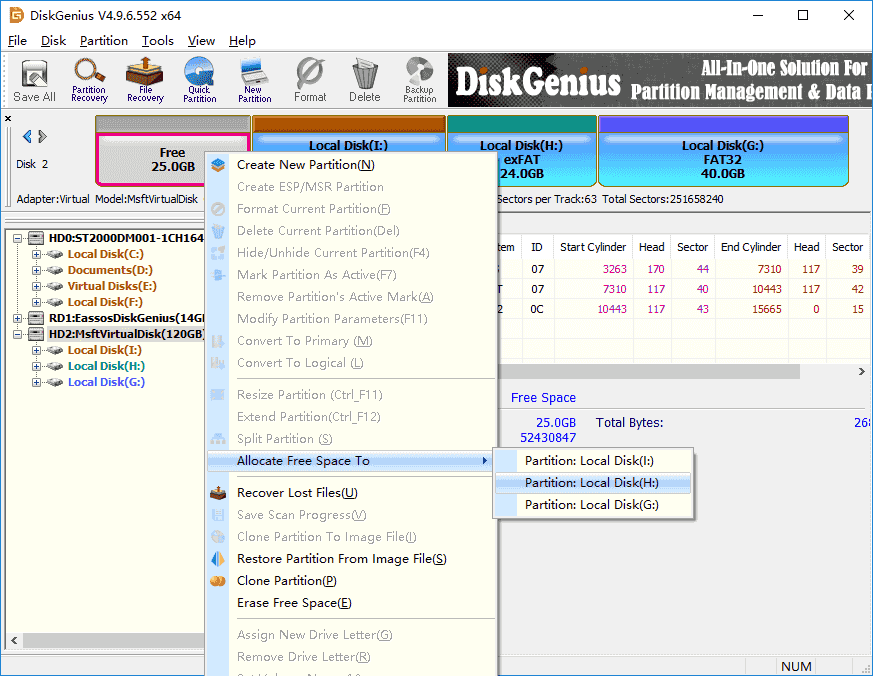
Step 2. DiskGenius prompts operations to be done. Click «Yes» and it starts adding unallocated space to partition.
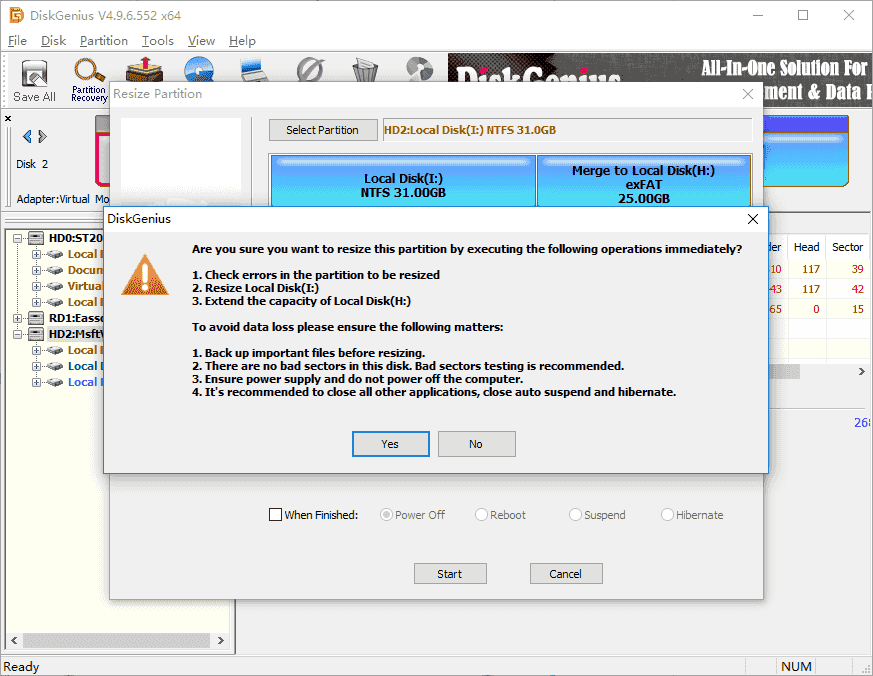
Method #3: Resize partition via repartitioning hard drive
Repartitioning a hard drive which is not properly partitioned is another solution to change partition size and partition number. During partitioning hard drive you can set partition type, number, size, volume name, drive letter, etc. thus you can arrange partition according to your needs.
Disk partitioning will delete all current partitions and data before creating new volumes, thus you’ll lose all data on the disk which already contains volumes. On this occasion, you need to backup data before repartitioning hard drive. Besides, you also need to reinstall Windows if the disk to be partitioned is the one where Windows is installed.
Before partitioning hard drive, you should plan partition layout in advance, for example, which partition table to use, how many partitions you need and what the partition size you want, etc. As to tools to partition/repartition a disk you can use free partition manager which makes the process intuitive and very simple. You can complete the process with several clicks.
Step 1. Connect the hard drive you want to repartition and launch DiskGenius Free Edition.
Step 2. Select the disk to be partitioned and click «Quick Partition» button from the toolbar.
Step 3. Select partition number, size, type, 4K alignment, etc. and click «OK» button. Wait for a couple of seconds and the disk will be partitioned successfully.
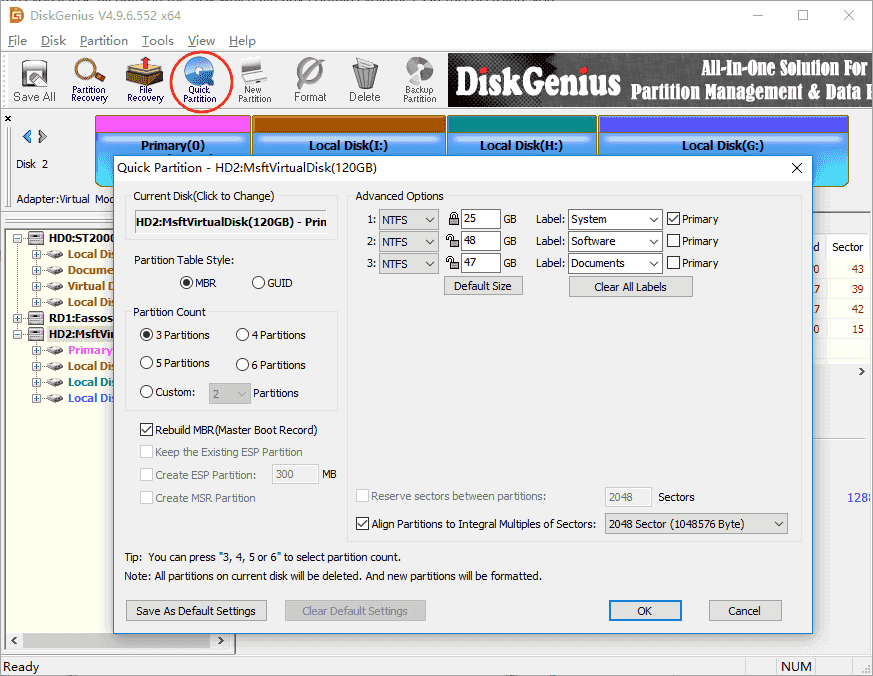
The do’s and don’ts
Though the partition resizing process is easy and does not cause data loss, there are some things you should pay attention to when resizing partition for data security.
- Backup data all data on partitions you want to resize. Though Disk Management and free partition manager changes partition size without losing data, there are still chances you will lose valuable data if the process gets interrupted due to certain causes.
- While resizing partition, do not read or write data to the partition being resized, especially when the process has to move files.
- The resizing process may take long when partition has large capacity and contains large amount of data. Make sure your computer won’t enter hibernate or sleep mode.
- Make sure the partition you want to extend or shrink does not contain errors, or the resize process might be blocked by these errors.
- Do not shun down before the resizing partition complete, and make sure there is not sudden power failure during resizing process.
Conclusion
As we’ve mentioned it is surprisingly easy to resize partition in Windows 11/10/8/7/XP, and you can either extend or shrink partition depending on your requirement. Both Disk Management and DiskGenius Free Edition can help you resize Windows partition, but the latter one works more efficiently when dealing with complex situations. Don’t be afraid to do it, but also don’t go overhead. Resizing a partition which contains errors may lead to severe issues such as data loss. If you have any questions or need help on resizing partition in Windows 10, please feel free to email our support team.
UPDATED 3/24/2025: On Windows 11, you can change partition size to either increase the drive size or use the unallocated space to create one or more partitions, and in this guide, I’ll show you how.
Regardless of the reason, you can resize a partition on Windows 11 without re-formatting or losing your files using the Settings app with the “Disks & volumes” settings, Disk Management, Command Prompt, and PowerShell. When using these tools, you can change the size of any partition, including the “C,” or the partition on any drive, including those from an external location.
In this guide, I’ll teach you the steps to shrink and extend the size of a partition on Windows 11.
- Change partition size with Settings on Windows 11
- Change partition size with Disk Management on Windows 11
- Change partition size with Command Prompt on Windows 11
- Change partition size with PowerShell on Windows 11
Change partition size with Settings on Windows 11
To change the size of a partition on Windows 11, use these steps:
-
Open Settings on Windows 11.
-
Click on System.
-
Click the Storage tab.
-
Click on Advanced storage settings under the “Storage management” section.
-
Click the “Disks & volumes” setting.
-
Select the drive with the partition (volume) to resize.
-
Select the partition and click the Properties button.
-
Click the Change size button under the “Size” section.
-
(Option 1) Confirm a lower number than the “Current” size to shrink the partition.
-
(Option 2) Confirm a higher number than the “Current” size but not larger than the “Max” number to extend the partition.
-
Click the OK button.
Once you complete the steps, the system will change the partition size without losing data to reflect the specified setting.
If you must extend the installation (C:) drive, you may have to delete and recreate the Recovery Partition before you can change the size of the main system partition.
Change partition size with Disk Management on Windows 11
Using the legacy Disk Management tool is the easiest way to shrink or expand the partition size on Windows 11.
Shrink partition
To shrink a partition on Windows 11 with Disk Management, use these steps:
-
Open Start.
-
Search for Create and format hard disk partitions and click the top result to open the Disk Management console.
-
Right-click the drive you want to change its partition size and select the Shrink Volume option.
-
Confirm the amount of space to shrink the partition (in megabytes).
Quick note: As you change the size value, you can confirm the total size of the unallocated space after shrinking the original partition.
-
Click the Shrink button.
Once you complete the steps, the partition will reduce to the specified size.
Extend partition
To increase (or extend) the drive partition size using Disk Management, use these steps:
-
Open Start.
-
Search for Create and format hard disk partitions and click the top result to open the Disk Management console.
-
Right-click the drive to change its partition size and select the Extend Volume option.
-
Click the Next button.
-
Choose the disk with available space under the “Selected” section (if applicable).
Quick note: In some cases, you may need to select the disk from the “Available” section and click the Add button to make it available.
-
Confirm the space to increase the drive partition (if necessary).
-
Click the Next button.
-
Click the Finish button.
After completing the steps, the drive partition will extend to the specified size.
If the “Extend volume” option is greyed out, the physical drive doesn’t have any space to increase the volume.
Change partition size with Command Prompt on Windows 11
It’s also possible to change the partition size without losing data on Windows 11 using the DiskPart tool with Command Prompt.
Shrink partition
To shrink a partition with Command Prompt on Windows 11, use these steps:
-
Open Start.
-
Search for Command Prompt, right-click the top result, and select the Run as administrator option.
-
Type the following command to start diskpart and press Enter:
diskpart
-
Type the following command to list the volumes and press Enter:
list volume
-
Type the following command to select the volume you want to shrink the partition and press Enter:
select volume 2
In the command, change “2” to the number representing the partition you want to modify.
-
Type the following command to determine the space you can decrease the partition and press Enter:
shrink querymax
-
Type the following command to shrink the drive partition by a specific amount (in megabytes) and press Enter:
shrink desired=7099
In the command, change “7099” for the amount (in megabytes) you want to shrink the partition.
-
(Optional) Type the following command to shrink the partition by its maximum space reclaimable and press Enter:
shrink
Once you complete the steps, DiskPart will reduce the size of the partition to the new smaller size.
Extend partition
To increase the drive partition size with DiskPart, use these steps:
-
Open Start.
-
Search for Command Prompt, right-click the top result, and select the Run as administrator option.
-
Type the following command to start diskpart and press Enter:
diskpart
-
Type the following command to list the available disks and their capacity, and press Enter:
list disk
Quick note: Identify the drive’s total size with the partition you want to increase.
-
Type the following command to list the volumes and press Enter:
list volume
-
Type the following command to select the volume to shrink the partition and press Enter:
select volume 2
In the command, change “2” for the number that represents the partition to modify.
-
Type the following command to increase the size of the partition and press Enter:
extend size=20480
In the command, change “20480” for the amount (in megabytes) you want to increase the partition.
-
(Optional) Type the following command to increase the size of the partition using all contiguous space on the drive and press Enter:
extend
After you complete the steps, the partition will extend to the new size without losing your data.
Change partition size with PowerShell on Windows 11
Alternatively, you can change partition sizes using PowerShell commands.
Shrink partition
To resize a partition with PowerShell, use these steps:
-
Open Start.
-
Search for PowerShell, right-click the top result, and select the Run as administrator option.
-
Type the following command to list all the drives and their total size, and press Enter:
Get-Disk
-
Type the following command to list the available partitions on the drive and Enter:
Get-Partition -DiskNumber 2
In the command, change “2” for the number of the drive with the partition to shrink.
-
(Optional) Type the following command to understand the minimum and maximum space you can resize the partition and press Enter:
Get-PartitionSupportedSize -DiskNumber 2 -PartitionNumber 2
In the command, change the disk and partition number corresponding to your situation. Also, the “SizeMin” and “SizeMax” are specified in bytes, which means that you may need to use an online converter to understand the information in gigabytes or any other size.
-
Type the following command to resize the partition to 5GB and press Enter:
Resize-Partition -DiskNumber 2 -PartitionNumber 2 -Size (5GB)
In the command, replace the partition number and size for the information corresponding to your drive and the size to shrink the drive. Also, I”m using GB, but you can also specify the space in bytes, KB, MB, and TB
Once you complete the steps, PowerShell will shrink the partition, leaving additional unallocated space to create additional volumes.
Extend partition
To extend the partition size with PowerShell, use these steps:
-
Open Start.
-
Search for PowerShell, right-click the top result, and select the Run as administrator option.
-
Type the following command to list all the drives and their total size, and press Enter:
Get-Disk
-
Type the following command to list the available partitions in the drive and press Enter:
Get-Partition -DiskNumber 2
In the command, change “2” for the drive number with the partition you want to extend.
-
(Optional) Type the following command to understand the minimum and maximum space you can resize the partition on Windows 11 and press Enter:
Get-PartitionSupportedSize -DiskNumber 2 -PartitionNumber 2
In the command, change the disk and partition number corresponding to your situation.
-
Type the following command to increase the partition to 9GB and press Enter:
Resize-Partition -DiskNumber 2 -PartitionNumber 2 -Size (9GB)
In the command, replace the partition number and size for the information corresponding to your drive and the size to increase the partition.
-
(Optional) Type the following command to extend the partition to its maximum size on Windows 11 and press Enter:
Resize-Partition -DiskNumber 1 -PartitionNumber 2 -Size 10720624128
In the command, replace the disk and partition number for the information that corresponds to your situation. Also, to specify the new size of the partition, use the “SizeMax” number available in step 4.
After completing the steps, the partition will cover the available space or the specified amount.
It’s important to note that sometimes partition and volume are used interchangeably, but they are different. For example, a “partition” is a logical division of a physical drive. You can divide a single drive into multiple partitions, allowing you to organize the storage, run multiple operating systems on the same drive, or separate different types of data.
On the other hand, a “volume” is a formatted storage area with a file system. It’s the logical unit that the operating system recognizes for storing and accessing files. A volume can reside on a single partition, but in some cases, it can span multiple partitions. In other words, a volume is a partition that has been formatted with a file system (like NTFS, FAT32, or ext4).
In summary, a “drive” is a physical piece of hardware, a “partition” is a logical division of the physical drive, and the “volume” is a formatted storage area with a file system, which may reside on a partition.
Update March 24, 2025: This guide has been updated to ensure accuracy and reflect changes to the process.
Публичное облако на базе VMware с управлением через vCloud Director
Изменение размера жестких дисков в Windows происходит в два этапа: сначала требуется изменить размер диска в панели управления, затем — внутри операционной системы.
Можно изменять размер как основного, так и дополнительных дисков.
Действия в панели управления
- На странице сервера перейдите на вкладку «Конфигурация»
- Кликните «Выбрать конфигурацию».
- Выберите тариф с нужным размером диска и нажмите «Сохранить и перезагрузить».
Данную процедуру необходимо выполнять только в случае, если на диске создано больше одного раздела. Во остальных случаях диск будет переразмечен автоматически и с вашей стороны никакие действия не требуются.
- Подключитесь к серверу по RDP.
- Кликните правой кнопкой мыши по кнопке «Пуск» и выберите «Управление дисками»:
- Если на диске, размер которого был изменен, требуется создать новый том, кликните правой кнопкой мыши по нераспределенной области диска и выберите «Создать простой том»:
- Если же необходимо расширить уже существующий том, кликните правой кнопкой мыши по существующему тому и выберите «Расширить том»:
Обратите внимание, что возможно изменить размер только крайнего тома. Например, при наличии на диске томов C и D, расширить можно только том D. Для расширения тома C предварительно потребуется удалить том D.
После система предложит выбрать размер, на который необходимо увеличить том. Вы сможете указать требуемое значение. Если же нужно выделить для тома всю нераспределенную область, просто оставьте значение без изменений:
Далее пройдите все предложенные системой шаги, после чего размер тома будет изменен.
Если размер тома не увеличился
Иногда при изменении размера диска вы можете получить ошибку «The parameter is correct». Как правило, в этом случае в разделе «Управление дисками» вы будете видеть новый размер диска, однако в свойствах диска будет по-прежнему отображаться предыдущее значение. Это связано с тем, что несмотря на то, что размер диска был увеличен, размер файловой системы остался прежним.
Исправить эту ошибку можно с помощью утилиты diskpart по следующей инструкции.
Запустите командную строку, кликнув правой кнопкой на «Пуск»→ «Командная строка (администратор)» (либо «Пуск»→ «Windows PowerShell (администратор)»).
Запустите утилиту командой:
diskpartОпределите номер тома командой list volume:
list volumeВыберите нужный том, указав его номер:
select volume номер_томаРасширьте файловую систему:
extend filesystemГотово. Для выхода из diskpart выполните:
exitБыла ли статья полезна?
Ваша оценка очень важна


